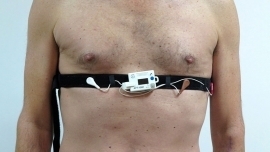Event recorder
What is it?
What is it?An event recorder is used to monitor heart rhythm disturbances over a prolonged period and can be provided to patients for a period of four weeks. It allows for two types of recording:
- Continuous recording over a period of four weeks. The patient can flag symptoms on the recording.
- Registration of heart rhythm disturbances alone. The patient carries the event recorder with them at all times and records heart rhythm disturbances as they occur.

What is the process?
What is the process?Preparation
The event recorder is fitted in a consultation room by a nurse or medical secretary. You will receive clear instructions about fitting the device and recording the heart rhythm. You will have the opportunity to try out these operations under supervision. If you are given a continuous system, you will also be provided with spare parts (e.g. adhesives) so that the recorder can be temporarily removed if required.
Procedure
You take the device home and carry out your daily activities as close to normal as possible. It is important to stand still and refrain from speaking during recordings. As the device is not waterproof, you may not shower or take baths. Sports are allowed so long as you use the device and protective cover in the correct manner. The test has no associated risks.
Aftercare
Skin irritation may occur where the electrodes were fitted. An anti-inflammatory ointment can alleviate this.
Results
ResultsThe entire recording is analysed using computer equipment. Any flagged symptoms are studied carefully and possibly related to heart rhythm changes. Any daily variations and the heart rhythm disturbances are checked. The results will be communicated in writing to your GP.
Centres and specialist areas
Centres and specialist areas
Something wrong or unclear on this page? Report it.
Latest publication date: 13/08/2024
Supervising author: Dr Provenier Frank




